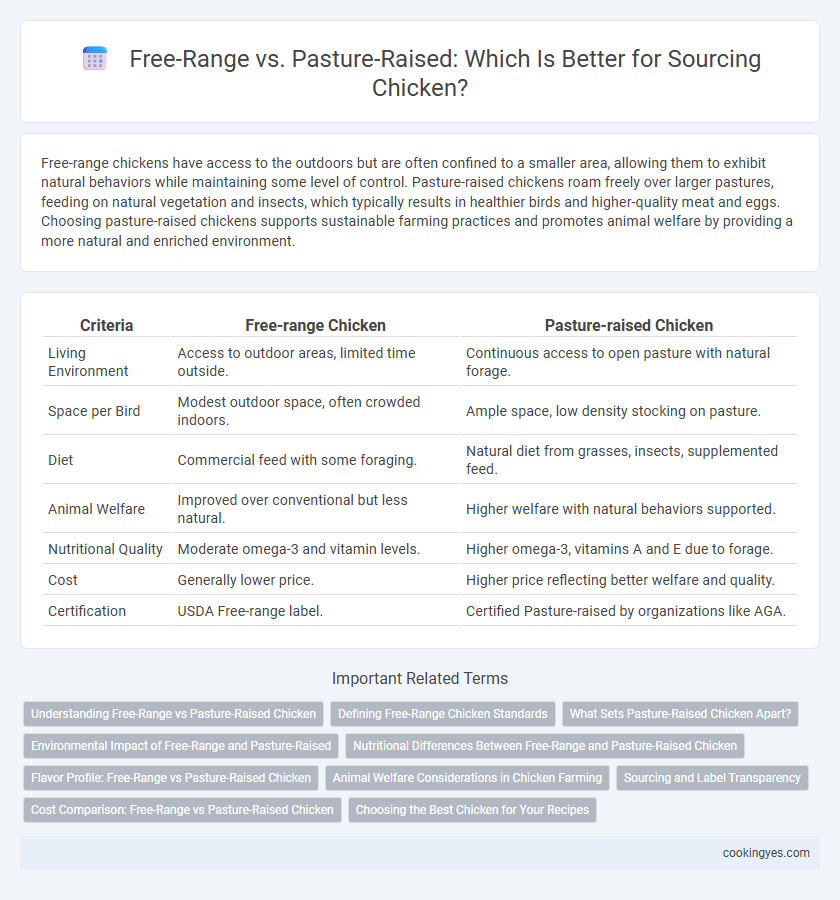Free-range chickens have access to the outdoors but are often confined to a smaller area, allowing them to exhibit natural behaviors while maintaining some level of control. Pasture-raised chickens roam freely over larger pastures, feeding on natural vegetation and insects, which typically results in healthier birds and higher-quality meat and eggs. Choosing pasture-raised chickens supports sustainable farming practices and promotes animal welfare by providing a more natural and enriched environment.
Table of Comparison
| Criteria | Free-range Chicken | Pasture-raised Chicken |
|---|---|---|
| Living Environment | Access to outdoor areas, limited time outside. | Continuous access to open pasture with natural forage. |
| Space per Bird | Modest outdoor space, often crowded indoors. | Ample space, low density stocking on pasture. |
| Diet | Commercial feed with some foraging. | Natural diet from grasses, insects, supplemented feed. |
| Animal Welfare | Improved over conventional but less natural. | Higher welfare with natural behaviors supported. |
| Nutritional Quality | Moderate omega-3 and vitamin levels. | Higher omega-3, vitamins A and E due to forage. |
| Cost | Generally lower price. | Higher price reflecting better welfare and quality. |
| Certification | USDA Free-range label. | Certified Pasture-raised by organizations like AGA. |
Understanding Free-Range vs Pasture-Raised Chicken
Free-range chickens have access to the outdoors but may spend a significant portion of their time inside barns, while pasture-raised chickens are primarily raised outdoors on natural pasture, promoting natural foraging behaviors. Pasture-raised systems typically provide chickens with more space, fresh air, and varied diets, resulting in higher nutrient density such as omega-3 fatty acids and vitamin E. Understanding these differences is essential for consumers seeking ethical sourcing and superior quality in chicken products.
Defining Free-Range Chicken Standards
Free-range chicken standards require that birds have some access to outdoor space during their growth, promoting natural behaviors and better welfare compared to conventional caged systems. The USDA mandates that free-range chickens must be allowed outdoor access, but the duration and quality of this access can vary significantly among producers. Understanding these standards is crucial for consumers seeking ethically sourced poultry with specific welfare and environmental considerations.
What Sets Pasture-Raised Chicken Apart?
Pasture-raised chicken differs from free-range primarily in the quality and extent of outdoor access, with pasture-raised birds having continuous access to fresh grass, insects, and natural forage on spacious pastureland averaging 250 to 500 square feet per bird. This environment promotes healthier growth, richer flavor, and higher nutrient density, including elevated omega-3 fatty acids and vitamins A and E. Certifications such as Certified Humane or American Pastured Poultry Producers Association (APPPA) standards ensure rigorous animal welfare and sustainable farm practices specific to pasture-raised labeling.
Environmental Impact of Free-Range and Pasture-Raised
Free-range chickens typically have access to outdoor areas that may be limited in size and vegetation, leading to moderate soil degradation and localized impact on biodiversity. Pasture-raised chickens graze on larger, well-managed grassy fields that support soil health through natural fertilization and reduced need for synthetic inputs, promoting a more sustainable ecosystem. Studies indicate that pasture-raised systems generally result in lower greenhouse gas emissions and better carbon sequestration compared to conventional free-range operations.
Nutritional Differences Between Free-Range and Pasture-Raised Chicken
Free-range chickens typically have limited outdoor access, resulting in a diet primarily of feed with occasional foraging, which can lead to moderate nutrient levels. Pasture-raised chickens roam freely on nutrient-rich grasses and insects, enhancing their meat and eggs with higher omega-3 fatty acids, vitamin E, and beta-carotene content. These nutritional differences make pasture-raised chicken a more nutrient-dense option compared to free-range chicken.
Flavor Profile: Free-Range vs Pasture-Raised Chicken
Free-range chicken offers a balanced flavor with moderate fat content, resulting in tender and juicy meat that appeals to many consumers. Pasture-raised chicken delivers a richer, more complex flavor profile due to varied diet and increased exercise, often described as earthier and more robust. These differences stem from the birds' access to natural forage and environment, impacting both taste and texture significantly.
Animal Welfare Considerations in Chicken Farming
Free-range chicken farming ensures birds have some access to outdoor areas, improving their ability to engage in natural behaviors like dust bathing and foraging, which enhances overall animal welfare. Pasture-raised chickens typically experience more space and extended outdoor access compared to free-range, leading to better physical health and reduced stress levels due to increased foraging opportunities and natural sunlight exposure. Both methods prioritize animal welfare more than conventional caged systems, but pasture-raised practices generally offer superior living conditions promoting natural behaviors and improved well-being.
Sourcing and Label Transparency
Pasture-raised chickens have access to open fields, allowing natural foraging, while free-range chickens receive limited outdoor access, often confined to a small area. Label transparency varies significantly, with pasture-raised certifications typically involving stricter animal welfare and environmental standards than free-range labels. Consumers seeking ethical sourcing should prioritize pasture-raised labels verified by third-party audits to ensure genuine outdoor access and humane treatment.
Cost Comparison: Free-Range vs Pasture-Raised Chicken
Free-range chicken typically costs less than pasture-raised chicken due to lower land and resource requirements, with prices averaging 20-30% lower per pound. Pasture-raised chicken benefits from extended outdoor access and natural foraging, which increases labor and maintenance expenses, driving the price higher. Consumers often pay a premium for pasture-raised options, reflecting the higher welfare standards and perceived quality differences.
Choosing the Best Chicken for Your Recipes
Free-range chickens have access to the outdoors, allowing natural behaviors but may be confined to smaller outdoor spaces, while pasture-raised chickens roam freely on large grassy areas with diverse vegetation, promoting higher nutrient content in meat and eggs. Pasture-raised chicken typically offers richer flavors and better texture due to a varied diet that includes insects and plants, enhancing recipes that require robust taste profiles. Selecting pasture-raised chicken supports sustainable farming practices and delivers superior quality, making it an ideal choice for chefs aiming to elevate their culinary creations.
Free-range vs Pasture-raised for chicken sourcing Infographic

 cookingyes.com
cookingyes.com